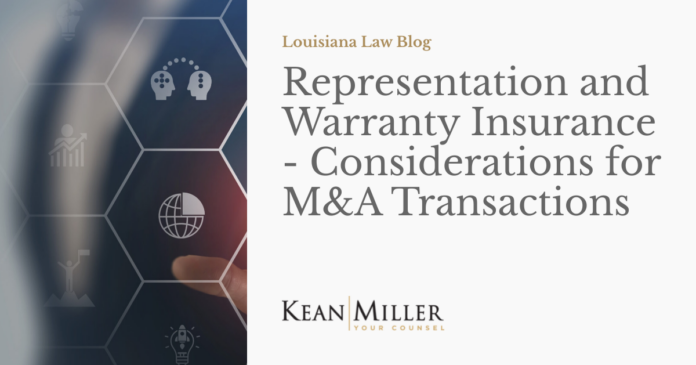
In M&A transactions, the seller makes representations and warranties to the buyer regarding the business being sold, its ownership, assets, operations, and liabilities. The seller typically indemnifies the buyer from losses incurred post-closing resulting from inaccuracies in those representations and warranties. This contractual structure is used by the parties to allocate certain known and unknown business risks between the buyer and seller. However, negotiation of these representations and warranties and the indemnity structure in the acquisition agreement can be a contentious and lengthy process. Buyers usually prefer broad indemnity from the seller for such post-closing losses, and sellers prefer to give a limited indemnity which is targeted to specific risks identified in the seller’s business.
Representation and warranty insurance (R&W insurance) is often an option which can help buyers and sellers avoid contentious negotiation of risk allocation by shifting some of the risks of an acquisition to an insurer.
R&W insurance provides coverage for indemnification claims a buyer may have for losses resulting from breaches of a seller’s representations and warranties in the acquisition agreement. The use of R&W insurance in M&A transactions has increased in recent years due to efficiencies in the insurance market, including lower premiums, better terms, and lower minimum transaction value.
R&W insurance policies can insure either the buyer or the seller in the transaction. Buy-side policies are the most common form of R&W insurance in private M&A transactions.
The viability of using R&W insurance in an M&A transaction depends largely on the size of the deal. Due to pricing constraints like premium costs and professional fees and expenses, R&W insurance may be cost prohibitive for deals valued less than $20 million. However, deals with transaction values between $10 million and $20 million are sometimes insured due to increased demand by buyers and sellers.
R&W insurance can benefit both the buyer and the seller in M&A transactions.
For the Seller, R&W insurance can (1) reduce the seller’s risk of liability for breaches of its representations and warranties by lowering or eliminating the seller’s indemnity obligations; (2) provide the seller with a cleaner exit from the business by reducing or eliminating the amount of proceeds held back by the buyer or placed in escrow; and (3) allow the seller to give the more extensive representations and warranties the buyer will want in the acquisition agreement, without as many “materiality” and “knowledge” qualifiers, leading to a quicker resolution of the form of acquisition agreement and thus an expedited closing.
For the Buyer, R&W insurance can (1) supplement or sometimes replace the indemnification protection provided by the seller by providing additional coverage beyond the liability cap and/or survival period in the acquisition agreement; (2) provide a secure source of recovery for losses resulting from breaches of the seller’s representations and warranties, particularly when recovery from the seller may be difficult; (3) allow the buyer to make a more attractive bid to the seller with no (or limited) escrow or holdback required, since the buyer will rely on the insurance for indemnification protection; and (4) preserve key relationships by mitigating the need for a buyer to pursue claims against sellers who will be working for the buyer post-closing.
The insurer will charge a premium for issuing the policy, generally ranging between 2% and 4% of the coverage amount. The policy coverage amount is typically a dollar amount equal to 10% of the transaction value. There will be a deductible amount under the policy that is excluded from coverage (the “retention”), generally set at 1% of the transaction value. So, if an M&A transaction value is $50 million, the policy coverage amount will be around $5 million, the policy premium will likely be around $100,000 – $200,000, and the retention will likely be around $500,000.
The cost of R&W insurance (including the premium) is often split 50/50 between the seller and the buyer; however, this can vary depending on the leverage of the parties in the negotiation of the acquisition agreement.
R&W insurance policies generally do not cover losses resulting from: (1) breaches of covenants; (2) purchase price adjustments; (3) contingent claims based on future events; and (4) matters that are known to the insured’s deal team before the inception of the policy (including all matters disclosed on schedules to the acquisition agreement and all matters discovered in due diligence). Other exclusions will likely apply under the policy, based on the results of the buyer’s and the insurer’s due diligence of the seller’s business.
The insurer will typically conduct its own due diligence of the seller’s business during the underwriting process, focusing on areas or issues that could lead to material liabilities. This process can add some additional time to close the transaction; however, efficiencies are often realized by repeat relationships between buyers, their advisors, and the insurance underwriters who have worked together on previous transactions and have developed a working understanding of each other’s processes.
Sellers and buyers should consult their advisors (attorneys, investment bank or broker) early in the process of an M&A transaction, preferably as early as in the letter of intent/term sheet stage, to determine if R&W insurance is a viable option for the transaction, as both parties may derive significant benefit from purchasing R&W insurance for the transaction.

